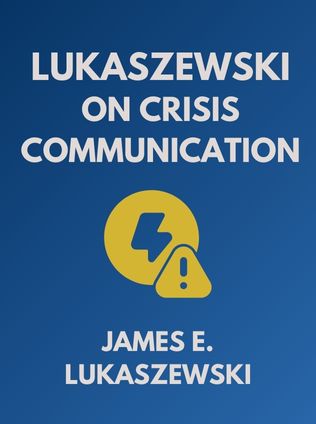
Lukaszewski on Crisis Communication
What Your CEO Needs to Know About Reputation Risk and Crisis Management
By James E. Lukaszewski
Published 03/2013
About the Author
James E. Lukaszewski is a renowned expert in crisis management and communication. As the president of the Lukaszewski Group Division of Risdall Public Relations, he has been named among the 100 top thought leaders of 2013 by Trust Across America. His contributions to the field are also highlighted in "Living Legends of American Public Relations." Lukaszewski has conducted numerous seminars and webinars for the Public Relations Society of America (PRSA) and the International Association of Business Communicators (IABC), attended by thousands, making him a respected voice in his field. His book, Lukaszewski on Crisis Communication: What Your CEO Needs to Know About Reputation Risk and Crisis Management, is a comprehensive guide for leaders navigating crises.
Main Idea
The main idea of Lukaszewski's book is to provide a detailed, actionable guide for CEOs and senior executives to effectively manage crises and protect their organization's reputation. He emphasizes the importance of readiness, the differentiation between crises and disasters, and the crucial role of managing the victim dimension in a crisis. Lukaszewski advocates for a proactive approach, stressing the need for comprehensive preparation, prompt action, and empathetic communication to mitigate the impact of crises.
Table of Contents
- Introduction
- Understanding Crisis and Disaster
- The Victim Dimension
- Leadership and Crisis Readiness
- Preparing for Crisis and Visibility
- Creating the Crisis Communication Plan
- Media Relations
- The Crisis News Conference
- Social Media
- The Activist Challenge
- Litigation and Legal Issues
- Summing Up and Looking Ahead
1. Introduction
Lukaszewski opens with a compelling scenario: "Your CEO's in handcuffs! Things are going downhill, fast!" This vivid image sets the stage for the urgent need for crisis management. He highlights the necessity for leaders to be prepared for unexpected events that could threaten their organization's stability and reputation. The introduction serves to captivate the reader's attention and underline the significance of the book's content.
2. Understanding Crisis and Disaster
Lukaszewski differentiates between crises and disasters. He defines a crisis as a "show-stopping, people-stopping, product-stopping, or reputation-defining, trust-busting event that creates victims and/or explicit visibility." Crises are typically caused by human actions, while disasters are usually natural events like tsunamis or earthquakes. Understanding this distinction is crucial for appropriate response strategies.
“Crises are caused by human beings through commission, omission, accidents, negligence or ignorance. Larger forces, generally natural events, usually cause disasters.” - James E. Lukaszewski
3. The Victim Dimension
Central to Lukaszewski's philosophy is the concept of the victim dimension. He argues that the treatment of victims determines the success of crisis response. Victims' needs for validation, visibility, vindication, and apology must be promptly addressed. This empathetic approach not only helps in reducing victimization but also mitigates potential litigation and negative media coverage.
- Validation: Acknowledging victims promptly.
- Visibility: Providing victims a platform to express their pain.
- Vindication: Ensuring actions are taken to prevent recurrence.
- Apology: Offering sincere apologies to reduce victimization.
“Victims have four powerful needs. If these four needs are provided promptly—preferably by the perpetrator—victims can more easily move through their state of victimization.” - James E. Lukaszewski
4. Leadership and Crisis Readiness
Effective crisis management begins with readiness. Lukaszewski outlines key components of readiness, emphasizing accurate contact information for key decision-makers, pre-authorization for rapid response, extensive scenario preparation, and the ability to handle surprises. He stresses that leadership involvement is crucial in fostering a culture of readiness within the organization.
Sign up for FREE and get access to 1,400+ books summaries.
You May Also Like
How To Win Friends and Influence People
The All-Time Classic Manual Of People Skills
By Dale CarnegieQuiet: The Power of Introverts
The Power of Introverts in a World That Can't Stop Talking
By Susan CainThe Lean Startup
How Today's Entrepreneurs Use Continuous Innovation to Create Radically Successful Businesses
By Eric RiesWho Moved My Cheese?
An Amazing Way to Deal with Change in Your Work and in Your Life
By Spencer Johnson, M.D.Make Your Bed
Little Things That Can Change Your Life...And Maybe the World
By William H. McRaven



















